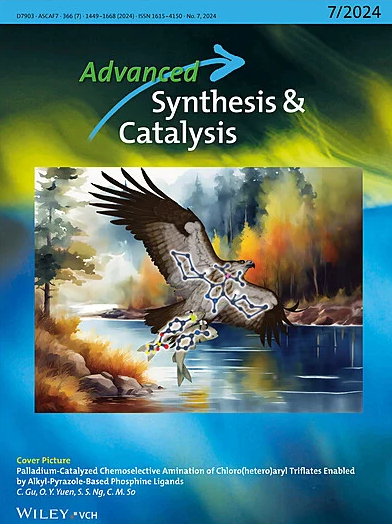苯甲酸醇与酮不对称形式交叉脱氢偶联的电氧化与脯氨酸联合催化
IF 4.4
2区 化学
Q2 CHEMISTRY, APPLIED
引用次数: 0
摘要
本文介绍了一种结合电氧化和有机催化的苯醇和酮的不对称形式交叉脱氢偶联方法。采用廉价环保的脯氨酸作为手性有机催化剂,以各种苯甲酸醇和简单酮为底物,直接得到各种手性β-羟基羰基化合物,收率中至高(可达85%),立体选择性好(可达99% ee和99:1 dr)。该反应在温和的室温空气条件下进行,没有氧化剂或添加剂,表现出强大的官能团耐受性和原子效率。在阴极释放的氢气是唯一的副产品。使用L-或d -脯氨酸可以直接获得β-羟基羰基化合物的两种手性构型。本文章由计算机程序翻译,如有差异,请以英文原文为准。
Combined Electrooxidation and Proline Catalysis for Asymmetric Formal Cross‐Dehydrogenative Coupling of Benzylic Alcohols with Ketones
This article presents a method for asymmetric formal cross‐dehydrogenative coupling of benzylic alcohols with ketones through combined electrooxidation and organocatalysis. Employing inexpensive and environmentally friendly proline as a chiral organocatalyst, various benzylic alcohols and simple ketones serve as substrates to directly obtain diverse chiral β‐hydroxycarbonyl compounds with moderate to good yields (up to 85%) and excellent stereoselectivity (up to 99% ee and 99:1 dr). The reaction proceeds under mild conditions at room temperature in air, without oxidants or additives, demonstrating robust functional group tolerance and atom efficiency. Hydrogen gas released at the cathode is the sole byproduct. Using L‐ or D‐proline allows straightforward access to both chiral configurations of β‐hydroxycarbonyl compounds.
求助全文
通过发布文献求助,成功后即可免费获取论文全文。
去求助
来源期刊

Advanced Synthesis & Catalysis
化学-应用化学
CiteScore
9.40
自引率
7.40%
发文量
447
审稿时长
1.8 months
期刊介绍:
Advanced Synthesis & Catalysis (ASC) is the leading primary journal in organic, organometallic, and applied chemistry.
The high impact of ASC can be attributed to the unique focus of the journal, which publishes exciting new results from academic and industrial labs on efficient, practical, and environmentally friendly organic synthesis. While homogeneous, heterogeneous, organic, and enzyme catalysis are key technologies to achieve green synthesis, significant contributions to the same goal by synthesis design, reaction techniques, flow chemistry, and continuous processing, multiphase catalysis, green solvents, catalyst immobilization, and recycling, separation science, and process development are also featured in ASC. The Aims and Scope can be found in the Notice to Authors or on the first page of the table of contents in every issue.
 求助内容:
求助内容: 应助结果提醒方式:
应助结果提醒方式:


